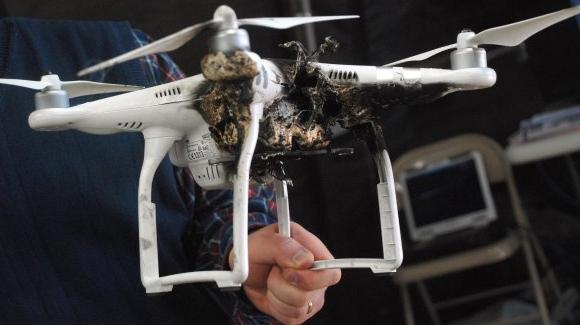Considering the possible types of direct energy weapons and analyzing the experiments that have been carried out in the world, it clearly emerges that the two most promising solutions are that of microwave weapons (HPM-DEW, High Power Microwave - Directed Energy Weapon) and of the Laser weapons (HEL - DEW, High energy laser - Directed Energy Weapon).
Microwave: HPM - DEW
The principle of operation of a microwave weapon system is fairly straightforward to understand.
It involves directing a microwave beam of a suitable frequency (usually 10Mhz ~ 100Ghz) towards a target (or a group of targets). Or even against a crowd.
Let's focus on HPM weapons designed to target assets and not people. I set out below some general considerations, taken from "cleared for public release" material, a bit dated but useful for general considerations1).
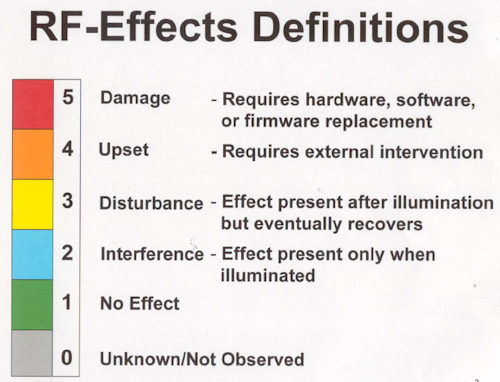 The effect of a microwave flux on a target that produces a type of damage of class 4 or 5 depends on the power density actually radiated on the target and on the subsystem on which you want to cause the damage (our goal could be to neutralize the communication system, or the guidance system, or to cause a complete mission failure). Well, regardless of the type of target and the subsystem it can be seen that the probability of failure (therefore successful of the weapon) reaches the maximum for about 100 Watt on cm2, but already at 10 Watt on cm2 the effects are significant.
The effect of a microwave flux on a target that produces a type of damage of class 4 or 5 depends on the power density actually radiated on the target and on the subsystem on which you want to cause the damage (our goal could be to neutralize the communication system, or the guidance system, or to cause a complete mission failure). Well, regardless of the type of target and the subsystem it can be seen that the probability of failure (therefore successful of the weapon) reaches the maximum for about 100 Watt on cm2, but already at 10 Watt on cm2 the effects are significant.
To reach, on the target, 10 or 100 W / cm2 how much power do we have to radiate through the antenna? Obviously it depends on how far away the target is (and on the other conditions that determine the dispersion of power from the radiant antenna to the target itself: reflections, buildings, etc.), but it also depends on other factors.
A general scheme for understanding how power propagates in a weapon system of the HPM - DEW type is shown in Figure 2. Beyond the details of the calculations1 it is important to focus some important qualitative aspects on the elements of the scheme.
The problems of the power generator (any RADAR is equipped with a suitably sized generator), of the losses due to the waveguides and of the losses due to propagation (proportional to the square of the distance to the target) are quite well known. It is more interesting to focus on the microwave source instead.
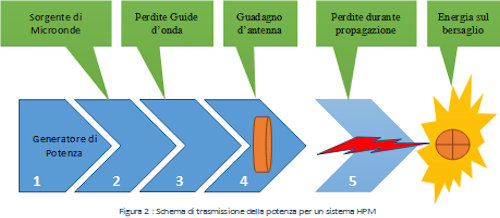 Regarding the microwave source, we can refer to the following figure to get an overview of the various usable technologies (graph taken from "1"and therefore unsuitable to cover recent evolutions), divided into vacuum and solid state technologies. Before interpreting the graph, it is good to keep in mind the following elements:
Regarding the microwave source, we can refer to the following figure to get an overview of the various usable technologies (graph taken from "1"and therefore unsuitable to cover recent evolutions), divided into vacuum and solid state technologies. Before interpreting the graph, it is good to keep in mind the following elements:
- The frequency corresponding to the greatest effectiveness of microwaves for DEW use is in the range between 300MHz and 3 GHz
- For a DEW use it is more effective a repetition of pulses with a duration from 100 ns to 1 µs rather than a continuous wave
The microwave source is clearly the most critical technological element of a DEW system, the one on which the power of the weapon is based, the one in which the technological superiority of a nation is most evident. It is no coincidence that microwave generators are included in the list of "sensitive" subsystems of which each state controls the development, production and export (they are in category 19 of the Italian military goods list and in category XVIII of US Munition List).
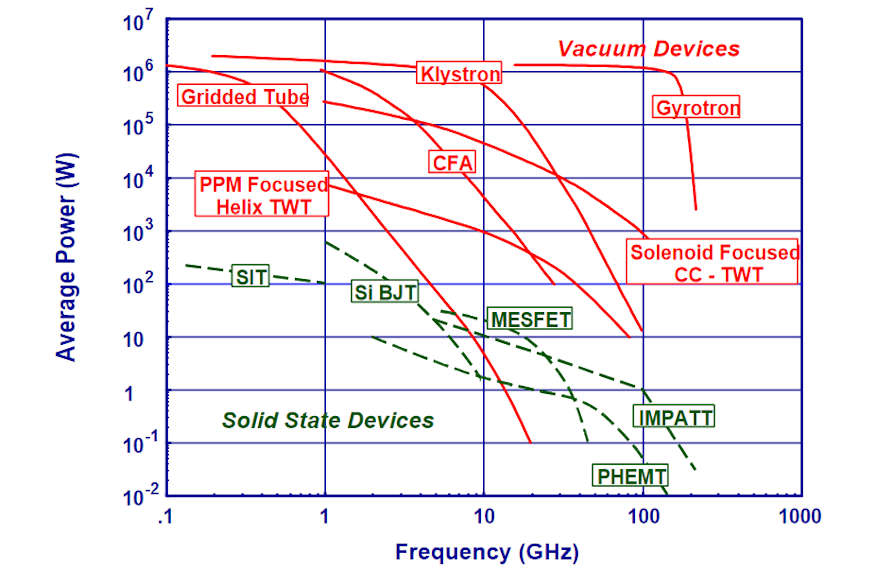
But there is another consideration that should be made. The diagram of Figure 2 clearly shows strong overlaps with a RADAR system. A Radar is certainly more complex, because it is intended to use microwaves to investigate the surrounding space and therefore has, compared to an HPM-DEW system, a part of receiving electromagnetic returns and an important part of signal processing. But the "brute" part of a Radar, relating to radio frequency emission, is also present in a DEW based on HPM. It is therefore easy to understand how one of the radar evolutions of recent years, namely the AESA technology of active beam management through a Phased Array, is certainly the subject of study in the field of HPM-DEW weapons.
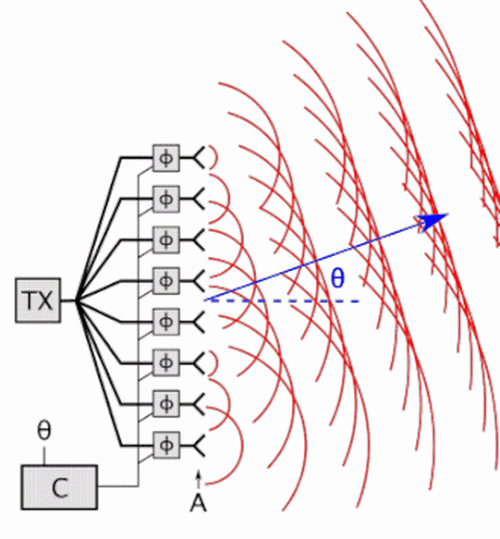
Just as a quick hint, the technology of phased array allows to replace elements 2, 3 and 4 of Figure 2 with a single antenna consisting of an arrangement on a plane of T / R modules (Transmitter / Receiver) each capable of transmitting a portion of the microwave beam (and, in the case of radar, to receive the return) delegating to the phase shift of the transmission instant of the individual modules the possibility of “modeling” the microwave beam resulting from the combined emission and of directing it even outside the antenna axis.
This technology, while in principle precluding "vacuum" microwave generators, allows for an important series of advantages, including: 1) beam directionality and 2) power scalability (the more radiating elements, the more powerful the beam).
Let's see examples of HPM-DEW systems in development or in use. Assuming, of course, that there are barriers to the dissemination of sensitive information and that, on the other hand, there is the possibility of targeted dissemination of false news (Information Warfare).
A prime example is the THOR prototype developed by the USAF research laboratory2. Designed to combat swarms of drones, it has aroused the curiosity of the US military which in 2021 financed a development that aims to deploy an HPM-based system by 2024 (IFPC, "3").
Regarding the situation of Russian developments, news of the availability of the Ranets-E system dates back to 20017. It is a kind of HPM cannon intended to neutralize (or decrease the effectiveness) of enemy missiles / systems. It is also possible to find some data, with all the inventory benefit due to the considerations reported in the introduction: frequency in the X band, 10-20 ns pulses, 500 MW of power, 500 Hz of PRF, range of action of 20 miles. It is not known if it has ever been used or if it is simply a prototype.
Chinese side, while considering all the barriers to the dissemination of sensitive information combined with the possibility of targeted dissemination of false news (Information Warfare), it seems that specific development activities for HPM systems have already been financed (project 863). It also appears that a prototype HPM-based weapon was installed on a ship to counter anti-ship missiles4.
Before ending the discussion of microwave-based weapons, we cannot fail to mention a further declination of the same concept, that relating to microwave bombs (E-Bomb, Electromagnetic bomb).
A microwave bomb is designed to hit enemy assets with a microwave beam, like the DEW-HPM weapons we've seen so far, but instead of using a reusable spawning device, it uses one-shot, so not reusable. These mechanisms, in addition to being able to be activated in the vicinity of the asset to be hit (as they are mounted on bombs, or even missiles), are by their nature capable of generating very high energy microwave pulses, currently not reachable with reusable devices. . More details5.
Most likely some E-Bombs were used by the US during the early stages of the Gulf War6.
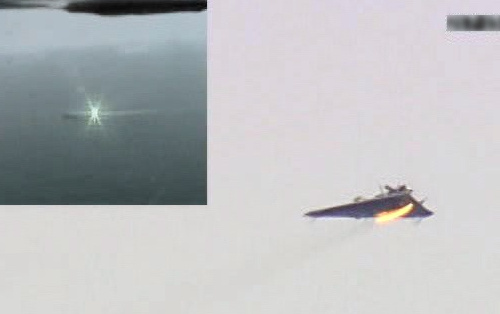
Laser: HEL - DEW
The second type of direct energy devices that we consider appropriate to investigate is that of high-energy lasers (High Energy Lasers, HEL).
It is quite intuitive to understand how a laser beam can be used to damage an enemy asset, given that laser cutting machines are already available on an industrial level. But the problems for the use of a laser as the basis of a weapon system are many and not easy to solve.
A first problem, trivial to understand, is related to the availability of a laser at a sufficient power to be used as a weapon. Unlike an HPM device, which inflicts effects on the circuits and subsystems of the asset, a Laser works by "heating" the portion of the affected asset. The result is that the energy flow must be as high as possible (therefore a pulse supply is not suitable). In order to transform a laser into a weapon it is therefore necessary to be able to generate a "powerful" laser beam.
The second problem it is due to the discourse of focus. If we take our laser pointer for a few euros and project it at a certain distance (just use it from a window on a street, when there is no one around, of course!) To verify how the "dot" we saw inside our room is smeared on the area corresponding to a tennis ball. We derive a concept that is also immediate to understand: if the energy is sufficiently concentrated at a short distance, it begins to dilute with increasing distance.
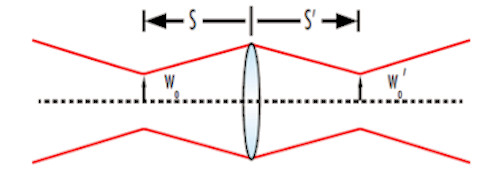 The idea of further "focusing" the laser is not so immediate. In fact, the luminous flux of the laser behaves like a "Gaussian flux" which follows its very precise and abundantly studied rules.8. In short, despite having an optical system so transparent and performing that it is not melted by the laser itself, it is not possible to focus a laser below a certain theoretical limit.
The idea of further "focusing" the laser is not so immediate. In fact, the luminous flux of the laser behaves like a "Gaussian flux" which follows its very precise and abundantly studied rules.8. In short, despite having an optical system so transparent and performing that it is not melted by the laser itself, it is not possible to focus a laser below a certain theoretical limit.
The third problem is that ... of mirages! There is no need to go to the desert, just take a paved road heated by the sun in the summer to see the illusory "pools of water", real mirages. It is only the effect of the light curved by the ascending air currents because they are heated by the hot asphalt.
What does it have to do with the laser? The laser is also “light”, and like light its beam is perturbed by the movements of the atmosphere that is between the emission source and the target. However, this is a problem that cannot be solved (see the solution adopted by USAF in the ABL system, which we will describe below)
The fourth problem is related to the third, and is known by the English term of "Thermal Blooming". We have already seen how atmospheric perturbations can affect the beam of a laser. What at first glance may not be evident is that the laser itself, by heating the air hit by the beam, causes by its nature a perturbation of the medium in which the beam propagates.
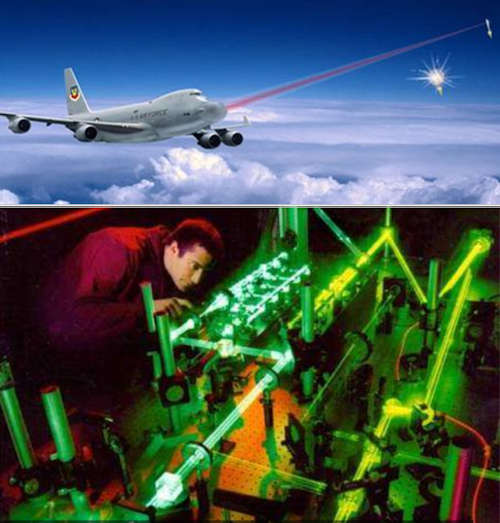
There is also a fifth aspect to be taken into account when examining a HEL-based system. With the powers at stake, not only does one have a phenomenon of thermal blooming, but the atmosphere heated by the Laser is subject to turn into plasma. And the effects of plasma interaction with the laser are complicated, difficult to model (they even require a relativistic treatment) and certainly affect the effectiveness of a HEL-based system. The economic and academic efforts to model and deal with this issue appear to be different, often financed (coincidentally!) By MoD and DoD9.
In short: from this roundup of problems it is evident that producing a weapon system based on a HEL is not simple, it does not simply consist in building a laser pointer a little larger, but is more focused on overcoming the current technological limitations and implementing mechanisms that cancel or minimize unwanted effects. But the facts show that instead the efforts on HEL-DEW type weapon systems are there and are multiplying in number and in the amount of the budget invested. Let's see some news that can make us understand the trend.
A system developed by the USA that is worth mentioning is the Air Based Laser (ABL) identified by the acronym YAL 1A.
It consisted in the installation, on a modified Boeing 747, of a high-energy laser and the subsystems necessary for effective beam pointing. The Laser is created with COIL technology (Chemical Oxygen Iodine Laser) and is a “Megawatt Class Laser”. The Laser is generated at the tail of the 747 while on the bow is mounted a system of mirrors (1.5 m in diameter) that directs the beam. It was a prototype project that was funded in 1996 by the US DoD for $ 1.1 billion, which saw the start of Flight tests in 2007 and two tests, the second of which ended the destruction of a ballistic missile after "A few seconds" of irradiation, always in the phase of boost. In 2014 the system was decommissioned10.
The solutions tested to cope with the problematic aspects of a HEL that have been listed above are very interesting in this project:
- An infrared system for initial target detection
- A low power, multiple beam laser lighting system (Track Illuminating Laser, TILL). It serves to determine the distance to the target and provide information on atmospheric conditions
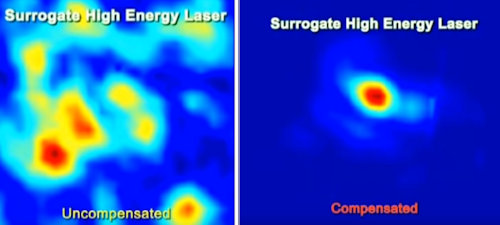
- A BEACON laser system (a kilowatt class laser) intended to illuminate the target and collect more accurate information on atmospheric turbulence in order to appropriately deform the main beam (generated by the COIL) and counterbalance the effects of the atmosphere.
The ABL experiment, obviously not directly aimed at obtaining an operational weapon system, made it possible to explore in detail the problems of a HEL-DEW system, to compare various technological solutions and to evaluate a series of solutions capable of minimizing the problems related to the use of the laser in the atmospheric environment.
From the same period as the ABL is the Tactical high energy laser (THEL), a joint program of Israel and the USA started in 1996. Compared to ABL it is a short-range HEL system, ground based, also designed in a mobile version (MTHEL). The results were acceptable, but strongly influenced by atmospheric conditions and therefore forced to a very short operating range.
If the ABL was decommissioned by the US in 2014, a US Navy laser system is operating instead, the Laser Weapon System (LaWS).
The system was born in an experimental section of the US Navy (Naval Surface Warfare Center, NSWC) before 2010. In 2010 a supplier (Kratos Defense & Security Solutions) was hired ($ 11M) to support the development.
The result is seen in 2014, when it is installed and declared operational on the USS amphibious transport unit Ponce11.
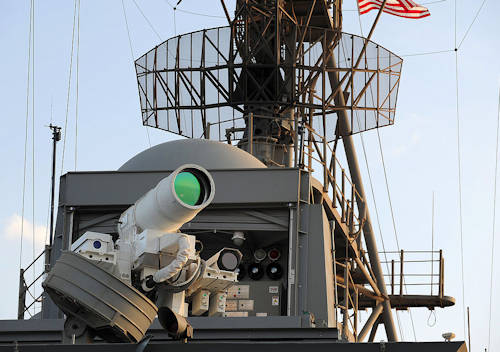
It is a laser with a power class of 10-50 KW capable of neutralizing small planes or fast boats. The main reason for its operational use is low cost: 59 cents per shot versus the expense of tens or hundreds of thousands of dollars for a missile.
The impressions of the users were very positive, so much so that the system will be moved to a new unit in anticipation of the decommissioning of the USS Ponce.
As evidence of the Navy's interest, in 2018 Lockeed Martin was awarded a $ 150M contract (HELIOS program) for the production of two other similar systems. They are easily traceable on the video network on the LaWS tests against a small boat and a UAV (v.link). There is no data on the distance of the targets, however it appears from the videos that they are no more than a few kilometers away. And in any case they are targets with “modest” dynamics.
Outside the USA it is important to mention a laser installation on an Ilyushin Il-76 (Beriev A-60 project) by the Soviet Union in the distant 70s, of which there is not much news apart from the alleged power (1MW), but which is important because it then gave rise to the Sokol-Eshelon project which seems to be aimed at disturbing enemy satellites (according to some sources, it illuminated a Japanese satellite in 200912.
If little is known about Russian systems, even less is known about Chinese HEL-DEW systems. But he is sure that China has been investing in the field for some time, if it is true that the 2006 annual report of the US DoD cites how China is engaged in "State-of-the-art research and development in laser technologies, including both low- and high-energy lasers" (state-of-the-art research and development on laser technologies, including low and high energy lasers). It also appears that in 2013 the Chinese attacked an American spy satellite with lasers14.
Let's close this quick roundup with Israel. It is recent news that Israel has also carried out a test on a laser system13. The system, mounted on a small CESSNA aircraft, managed to neutralize a UAV about a kilometer away. Several other tests at various altitudes are also cited. What is important in this experiment is: UN that Israel (which has clear needs for the defense of its territory) is investing in the field and has already achieved tangible results, DUE who managed to install the system on a small plane (ABL required the adaptation of a 747) and THREE that the Minister of Defense and the IAF development manager have clearly outlined a development path that sees as the final stage a 100Kw HEL-DEW System operational in 2024 and deployed along the Gaza border.
Also read: "Direct Energy Weapons, DEW (part 1/3): introduction and classification"
Also read: "Direct Energy Weapons, DEW (part 3/3): considerations on systems and prospects for use"
1 High Power Microwave Technology and Effects, University of Maryland short course for MISC (Missile and Space Intelligence Center) at Redstone Arsenal (https://user.eng.umd.edu/~vlg/MSIC%20lectures.pdf)
2 THOR, https://afresearchlab.com/technology/directed-energy/successstories/coun...
3 New HPM development, https://www.defensedaily.com/topic/indirect-fire-protection-capability-i...
4 Chinese anti-ship HPM, https://www.uscc.gov/sites/default/files/Fisher_Combined.pdf
5 e-bomb, http://www.ausairpower.net/PDF-A/AOC-PACOM-Kopp-Oct-2012-A.pdf
6 E-bomb in the Gulf War, https://www.globalsecurity.org/military/systems/munitions/hpm.htm
7 Ranets-E, Russian HPM, https://thaimilitaryandasianregion.wordpress.com/2016/01/19/ranets-e-hig...
8 Gaussian Beam Propagation, https://www.edmundoptics.com/knowledge-center/application-notes/lasers/g...
9 The intense laser-plasma interaction proposal, https://www.osc.edu/sites/default/files/page-files/Major%20Proposal%20Ex...
10 ABL programme, https://www.airforce-technology.com/projects/abl
11 Laws declared operational, https://www.military.com/daily-news/2014/12/10/navy-declares-laser-weapo...
12 Sokol-Eshelon Test, http://russianforces.org/blog/2011/10/russia_has_been_testing_laser.shtml
13 Israel Laser testing, https://www.jpost.com/israel-news/israel-successfully-downs-targets-usin...
14 High Energy Laser Directed Energy Weapons technical report, http://ausairpower.net/APA-DEW-HEL-Analysis.html#mozTocId698123
Photo: US DoD / University of Maryland / web / US Navy

